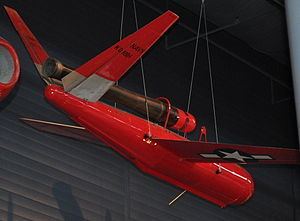Manufacturer McDonnell Aircraft | ||
 | ||
The McDonnell TD2D Katydid was an American target drone produced by McDonnell Aircraft that began development in 1942.
Contents
History
The U. S. Navy awarded McDonnell Aircraft a contract for a radio-controlled target drone in 1942 under the designation of XTD2D-1 for anti-aircraft and aerial gunnery practice. Production models, built in unknown quantity, used the designation of TD2D-1. The Navy changed its designation system in 1946 and the XTD2D-1 and TD2D-1 were redesignated as XKDD-1 and KDD-1, respectively. Later that year, the Navy changed McDonnell's manufacturer code letter from "D" to "H", and the KDD-1 was redesignated again as KDH-1.
Description
The most unusual features of the TD2D were the externally mounted pulsejet engine and the V-tail. The gasoline-powered, 8-inch-diameter (203 mm) engine was built by McDonnell, but it is unclear how much it was derived from the Argus pulsejet used on the German V-1. The drone was probably named after the Katydid because it had narrow wings and made a loud, pulsing sound like a pulsejet. The drone could be either launched by catapult from the ground or from underwing racks on Consolidated PBY Catalina seaplanes. It was gyro-stabilized, radio-controlled and could be recovered by parachute.
Specifications (KDD-1)
Data from Placard at Udvar-Hazy and KDH webpage
General characteristics
Performance
